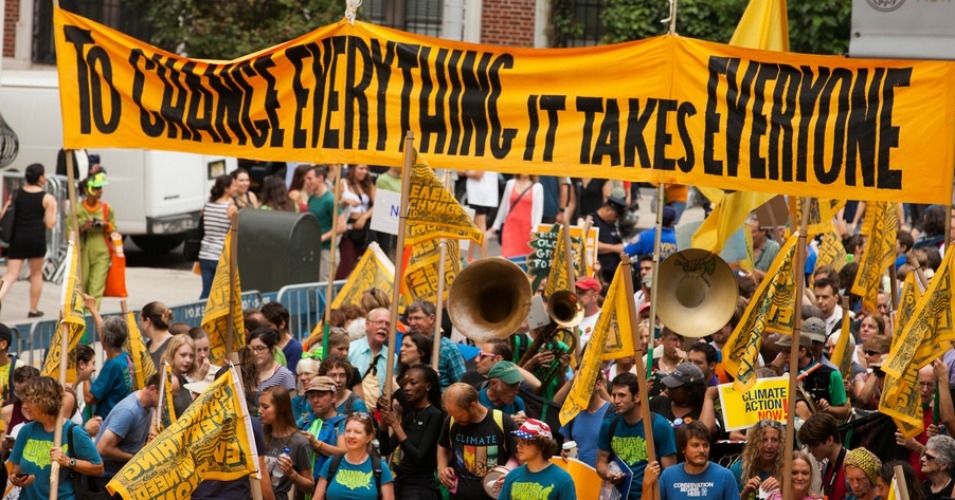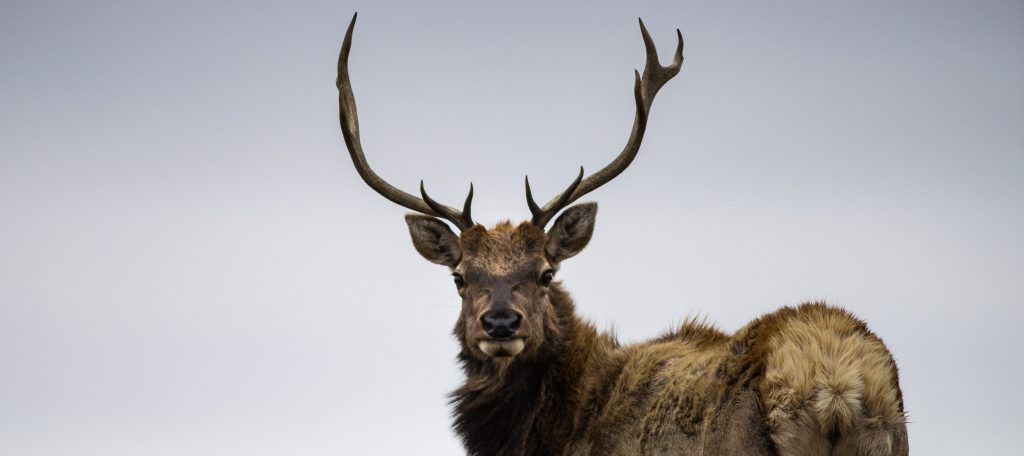The regenerative agriculture movement is quickly building momentum, its ideas spreading among environmentalists, food activists, and even the general public. Advocates of regenerative agriculture contend that holistic, “well-managed” grazing is central to restoring ecosystems, fighting desertification and climate change, and building sustainable food systems. I live in the Bay Area, where before this recent upsurge there was already a strong local food movement that idealized traditional forms of animal husbandry and saw them as part and parcel of a sustainable food system based on small-scale farming. It is in this context that regenerative agriculture has swept in as the new gospel.
In 2016 and 2017 I spoke at Soil Not Oil, a grassroots environmental conference that takes place in Richmond, CA and that largely focuses on sustainable agriculture. Each time, my panel was the only one to touch upon veganic agriculture. In 2016, I sat in the main auditorium to prepare my presentation while a video about agroecology played on the large screen. I typed my notes on veganics to the sound of Vandana Shiva speaking of manure and expressing the common view that the only alternative to it is an agricultural system run on fossil fuels. This false dichotomy between sustainable farming and veganism is now widely accepted as truth.
The lunch at Soil Not Oil 2016 included vegan options but the trend was clearly moving in the opposite direction. I was told that the year before, meals had mostly been vegetarian and a volunteer made an announcement about the importance of eating plant-based. In 2016, that was off the radar. By 2017, regenerative grazing stood out as the hot topic of the conference.
The EcoFarm conference draws many sponsors and attendees and at its 38th edition last January in Pacific Grove, CA, the focus was entirely on regenerative agriculture. A month later, the third Western Regional Grazing Conference, titled Grazing for Change, took place in Chico, CA. Many of the presenters (and sponsors) at these events are the type of California rancher whose products have exploded in popularity in the Bay Area. With the barrage of pro-grazing events and rhetoric within environmental circles, it is impossible to ignore the broader effects on food culture in the Bay Area.
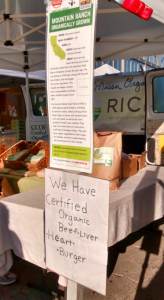
For example, the popular Saturday Farmer’s Market at the San Francisco Ferry Building is replete with all sorts of meats, cheeses, eggs and even furs from local ranches. The inside of the Ferry Building is a foodie tourist destination with a preponderance of meat companies and restaurants that specialize in local, sustainable animal fare. There’s also Cowgirl Creamery, which sources its products from Marin County organic dairy farms and is so beloved that it doubled its size last year. In San Francisco, several hip coffee shops don’t offer soymilk because of “sustainability” but they do offer cow’s milk, often of the local brands Clover or Straus. Straus Family Creamery, incidentally, sponsors the Soil Not Oil and EcoFarm Conferences.
Ranchers have always had clout in the American West; their present leadership in the environmental movement is anything but subversive. Attendees of these conferences and buyers of local grass-fed fare are seduced by phrases like “4th generation cattleman”. They conjure a romantic image of being rooted in the land and in step with nature, making ranchers perfectly suited to lead us out of corporate domination. For me, these phrases are reminders that the appeal of ranchers stems not from an underdog status but from their central role in generations of colonial agriculture.

The food movement has long been an opposing force to the animal liberation movement and now it has become more so. In its promotion of local, organic, traditional, or agroecological food production, this movement has defaulted to a view in which domesticated animals necessarily play a part. Manure is the organic fertilizer par excellence, an idyllic homestead is sure to have a few “happy” chickens running around, and it doesn’t get more local and rustic than buying artisanal cheese from the organic dairy farms a few miles north of San Francisco. By seeming to equate all animal agriculture to factory farms and by focusing on animal instead of industrial agriculture, vegans are perceived as disconnected from the true solutions and to be throwing the baby out with the bathwater. Now that farm animals are no longer merely a default component of the organic ideal but rather a magic bullet, this conflict is heightened.
Proponents of regenerative agriculture misrepresent vegans as advocating for ecosystems without animals. They posit that animals fulfill integral functions in their ecosystems and that without them, an ecosystem can only be unhealthy and an agricultural system can only be unsustainable. Nobody is disagreeing with them, but we don’t need to commodify animals for animal life to be present. In fact, grazing in California is wiping out the diversity of animal life to make way for a few species we have decided to subjugate and profit off of.
In the United States, farm animals are exotic species that were introduced by settlers and that have been in conflict with native wildlife since the beginning of colonization. The native Tule elk and bison could be fulfilling their ecological roles as ruminants, instead they continue to die off and to be killed because ranchers are given preferential access to land and tax dollars. Apparently all the talk of needing ruminants to build soil is less appealing when we can’t line our pockets with them.
As Angel Lynn puts it, “There are many ways [that animal agriculture] impacts wildlife. The majority of animal products come from large-scale farms. If animals aren’t in factory farms or CAFOs (controlled animal feeding operations), then they are grazing. People think this is better – the ideas of grass-fed and free-range are very popular – but what is happening is that farmers are stealing the land from the wildlife to use for cows and whomever else they’re grazing. This often requires killing wild animals through trapping, shooting or ‘aerial gunning’, poisoning and many other ways. These animals are exterminated so we can use the land to graze food animals. Wild horses are also rounded up; there are many places in the U.S. where wild horses live on the land and they just round them up and corral them so the land can be used to raise cows. It’s horrendous.” In the Bay Area, organic dairy farming has caused the deaths of native Tule elk due to fencing and competition over water and forage, yet dairy farms continue to successfully market themselves as stewards of the land.
It is often acknowledged that cows are not native; the argument goes that roaming bison used to fulfill key ecological functions in the grasslands and that since they’ve – sadly – disappeared, cows are our next best bet. What’s not usually acknowledged is that large herbivores, including the native bison, continue to be systematically massacred and deprived of their habitat to make way for cows. On the yearly bison cull that takes place in Yellowstone Park, Stephany Seay of the Buffalo Field Campaign says “Montana livestock interests are in control of the state legislature, and they are anti-buffalo. They always cry that it’s about brucellosis, but not even brucellosis-free bison are welcome anywhere. This is a war about grass and who gets to eat it.”
Even if large ruminants or herbivores were indeed absent and necessary to a given region, why can’t we imagine bringing animals into nature without commodifying them, micromanaging their whole existence and cutting short their natural lifespan? It is also curious that, when it comes to animals, the problems caused by the near-extinction of native species are to be solved by bringing in more of the invasive species. This is the opposite strategy that we have with plants. I often witness the care that conservationists apply to the restoration of native habitats: native species are replanted, areas are fenced off and invasive plants are diligently removed or even sprayed with pesticide, one by one, to give native plants a better chance. Cows are responsible for the loss of food sources and habitat of native animals–and somehow more cows are the solution?
If we want an honest discussion on the role of animals in our ecosystems, it will have to include the wildlife that is commonly disappeared from the picture. In unpacking the arguments for grazing, ecologist George Wuerthner points out that “there are plenty of native herbivores though most ranchers either ignore them or are completely ignorant of their existence”. Of course, the frequent mention of the ecological role of cows is not to invite the public to in-depth discussions, but to drill the association between nature and animal agriculture.
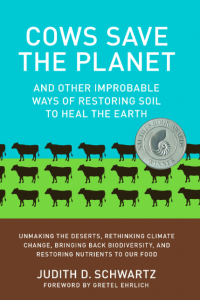
Likewise, we hear at length of the importance of grasslands in sequestering carbon and that of cows in restoring grasslands. Even if this were correct, it wouldn’t address issues with grazing in non-grasslands, for example the deforestation that is caused by ranching. However, the grasslands rhetoric functions to instill a general goodwill towards grazing and thereby to turn less attention to, say, the razing of the Amazon rainforest to graze some poor cows. When you’ve grown up with the idea of the Old McDonalds farm, it’s easy to be sold on the image of a cow in a pasture as the perfect use of the land.
The new enlightened crowd of graziers is not unlike the old crowd of graziers, who saw the colonization of the West through ranching as their divine right and duty. The cows introduced to California were not merely a byproduct of European presence but rather a key driver and mechanism of colonization. Present-day pro-grazing propaganda recycles ideas of Manifest Destiny, whereby the land is brought to its full potential through European agriculture. These days, the narrative is that cows are necessary to “heal” the soil and save us from a catastrophic future. The public buys it because of convenience (you can have your steak and feel virtuous too) and because Eurocentrism and the cultural legacy of settler colonialism endow pro-grazing arguments and imagery with intuitive appeal.
Ranchers did not save the land when they first arrived in California and they are not saving it now. The false dichotomy between veganism and sustainable agriculture serves to protect a culture of carnism but it also harms the environment, as the environmental movement fails to consider the potential benefits of shifting to plant-based ecological farming systems. Domesticated animals are not a necessary component of ecological farming and doing without them would help protect biodiversity, save water and land, decrease greenhouse gas emissions and still build soil to sequester carbon.
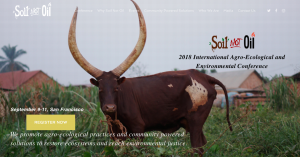
This September, San Francisco will host the Global Climate Action Summit and our city will become a hub of international activity. The Soil Not Oil Conference will take place in the middle of all this and will attract activists from around the world who are keen to fight global warming by changing our food system. I am hoping to speak again on veganic farming so that animal-based systems are not the only face that we present of sustainability.
I urge other vegans to also show up for this type of work. It is not enough for our movement to focus on eating habits: we must put forth a vision of what ecological farming can look like post-animal liberation, if only to redress the false dichotomy that is used to legitimize animal exploitation. And I urge other environmentalists to finally join us in calling for the end of animal agriculture.
On September 8 I will be marching under the banner “Veganic For Climate” at the People’s Climate March in San Francisco. I invite you to join me in the streets and build a veganic future.
There are many other ways you can help shift away from industrial and animal agriculture, starting by supporting the farmers who are already creating the change we wish to see. Support them financially; share their stories; sponsor them to offer courses and attend conferences; sponsor young farmers to intern with them. Support organizations like Vegan Organic Network, Wild Earth Farm and Sanctuary, Empty Cages Design, Vegan Advocacy Initiative and Seed the Commons, who promote sustainable farming that is free of animal exploitation.
